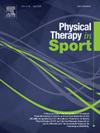术前特点及运动训练水平对前交叉韧带重建后恢复运动的影响。
IF 2.2
3区 医学
Q1 REHABILITATION
引用次数: 0
摘要
目的:1)比较成功(sRTS)和不成功(noRTS)患者在aclr后24个月恢复运动的术前特征、损伤前运动水平和6个月恢复结果;2)确定术前特征或伤前运动水平是否能预测noRTS。设计:纵向队列研究。参与者:40例ACLR患者。主要观察指标:收集术前特征,采用Tegner和Marx问卷及Noyes体育活动评定量表(NSARS)评估运动实践水平。6个月时进行第二次评估。24个月时,患者分为两组:sRTS组和noRTS组。结果:noRTS组损伤前NSARS评分(92.5[80;100])高于sRTS组(85 [72.5;86.2];p = 0.03)。最能预测noRTS的多变量模型(AUC = 0.83; p = 0.011)包括较高的伤前NSARS (AOR = 1.07 [1.01-1.14]; p = 0.001)、较多的相关损伤(AOR = 1.55 [0.98-2.42]; p = 0.043)和较长的损伤至手术时间间隔(AOR = 1.15 [0.91-1.46]; p = 0.21)。结论:临床医生应考虑伤前NSARS评分高、多发伴发损伤、手术延迟等关键危险因素,针对性地进行康复治疗,提高aclr术后24个月恢复到伤前运动水平。本文章由计算机程序翻译,如有差异,请以英文原文为准。
Influence of pre-surgery characteristics and sports practice level on return to sport after ACL reconstruction
Objectives
1) To compare pre-surgery characteristics, pre-injury sports level, and 6-month recovery outcomes between patients with successful (sRTS) and unsuccessful (noRTS) return to sport at 24 months post-ACLR; 2) To identify whether pre-surgical characteristics or pre-injury sports level predict noRTS.
Design
Longitudinal cohort study.
Participants
40 patients with ACLR.
Main outcome measures
Pre-surgery characteristics were collected and the level of sports practice was assessed using Tegner and Marx questionnaires, and the Noyes Sports Activity Rating Scale (NSARS). At 6 months a second evaluation was conducted. At 24 months, patients were divided into two groups: sRTS and noRTS.
Results
Pre-injury NSARS score was higher in noRTS (92.5 [80; 100]) compared to sRTS group (85 [72.5; 86.2]; p = 0.03). The multivariate model that best predicts noRTS (AUC = 0.83; p = 0.011) combines a higher pre-injury NSARS (AOR = 1.07 [1.01–1.14]; p = 0.001), more associated injuries (AOR = 1.55 [0.98–2.42]; p = 0.043), and longer injury to surgery time interval (AOR = 1.15 [0.91–1.46]; p = 0.21).
Conclusion
Clinicians should consider key risk factors (e.g. high pre-injury NSARS score, multiple associated injuries, delayed surgery) to tailor rehabilitation and improve return to pre-injury sports level 24 months post-ACLR.
求助全文
通过发布文献求助,成功后即可免费获取论文全文。
去求助
来源期刊

Physical Therapy in Sport
医学-康复医学
CiteScore
4.50
自引率
8.30%
发文量
125
审稿时长
39 days
期刊介绍:
Physical Therapy in Sport is an international peer-reviewed journal that provides a forum for the publication of research and clinical practice material relevant to the healthcare professions involved in sports and exercise medicine, and rehabilitation. The journal publishes material that is indispensable for day-to-day practice and continuing professional development. Physical Therapy in Sport covers topics dealing with the diagnosis, treatment, and prevention of injuries, as well as more general areas of sports and exercise medicine and related sports science.
The journal publishes original research, case studies, reviews, masterclasses, papers on clinical approaches, and book reviews, as well as occasional reports from conferences. Papers are double-blind peer-reviewed by our international advisory board and other international experts, and submissions from a broad range of disciplines are actively encouraged.
 求助内容:
求助内容: 应助结果提醒方式:
应助结果提醒方式:


